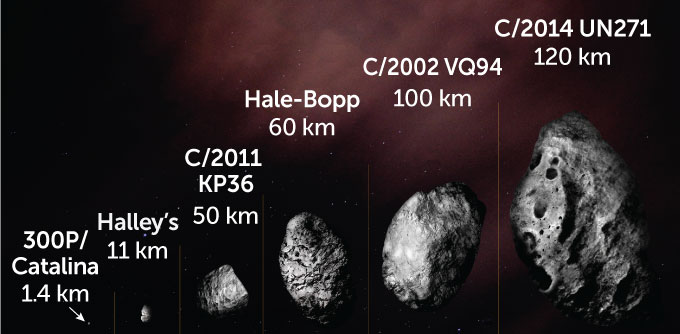The nucleus of a comet discovered in 2014 is the largest ever spotted.
The “dirty snowball” at the center of comet C/2014 UN271 is about 120 kilometers across, researchers report in the April 10 Astrophysical Journal Letters. That makes this comet — also known as Bernardinelli-Bernstein, after its discoverers — about twice as wide as Rhode Island, says David Jewitt, an astronomer at UCLA.
Though the comet is big — and vastly larger than Halley’s comet, which measures a little more than 11 kilometers across — it will never be visible to the naked eye from Earth because it’s too far away, Jewitt says (SN: 12/14/15). The object is now about 3 billion kilometers from Earth. At its closest approach in 2031, the comet will come no closer to the sun than 1.6 billion kilometers, about the same distance as Saturn.
Big, bigger, biggest
The nucleus of comet C/2014 UN271 (illustrated, far right), also known as Bernardinelli-Bernstein, is much larger than other known comets, including Halley’s and Hale-Bopp. Comet sizes are approximate, average diameters measured across their elongated bodies.
Known comet nucleus sizes in the solar system NASA, ESA, Zena Levy/STScINASA, ESA, Zena Levy/STScI
NASA, ESA, Zena Levy/STScINASA, ESA, Zena Levy/STScI
Jewitt and colleagues sized up the comet with the help of new images from the Hubble Space Telescope, combined with images taken by another team at far-infrared wavelengths. The analysis also revealed that the comet’s nucleus reflects only about 3 percent of the light that strikes it. That makes the object “blacker than coal,” Jewitt says.
Comet Bernardinelli-Bernstein takes about 3 million years to circle the sun in a highly elliptical orbit. At its farthest, the comet may reach about half a light-year from the sun — about one-eighth of the distance to the next nearest star.
The comet is likely “just the tip of the iceberg” as far as undiscovered comets of this size go, Jewitt says. And for every comet this size, he suggests, there could be tens of thousands of smaller objects circling the sun undetected.

Sign Up For the Latest from Science News
Headlines and summaries of the latest Science News articles, delivered to your inbox
Client key* E-mail Address* Go
Thank you for signing up!
There was a problem signing you up.

